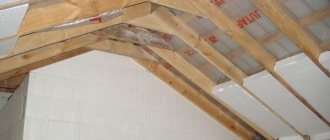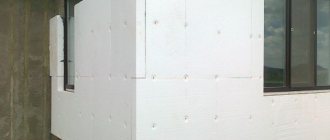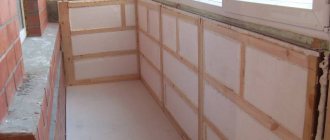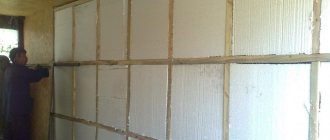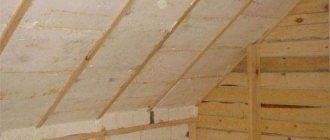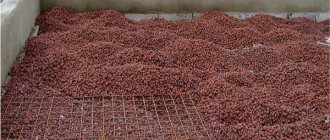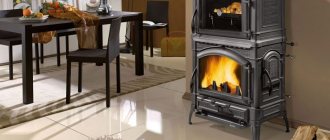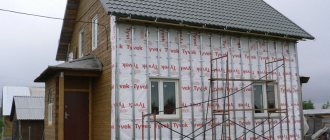Various materials are used to insulate roof structures. One of the most commonly used materials are polymer-based heat insulators. Insulating a roof with polystyrene foam is quite simple and quick; you can carry out this operation on your own, without the involvement of specialists. After reading this article, you will learn the technological process of roof insulation using polystyrene foam, as well as all the priority points that should be taken into account before carrying out work.
What is hidden under the name “foam plastic”?
Foam plastic is the popular name for expanded polystyrene. But it is worth distinguishing between simply expanded polystyrene and extruded polystyrene foam.
Polystyrene is a product of the polymerization of styrene, which is quite clear from the name alone. In appearance, polystyrene is hard, elastic and colorless. It does not have high mechanical bending or tensile strength, and low density. Even lenses are made from this substance, not to mention dishes and other household items.
Expanded polystyrene is foamed polystyrene, which is produced in the form of sheets up to 20 cm thick and can vary in density. It costs much less than extruded polystyrene foam, is more friable and has a more limited scope of application.
The name of extruded polystyrene foam comes from its production method - extrusion, when the raw material is squeezed out through certain holes of the same size. Even more precisely: extruded polystyrene foam is a gas-saturated melt of polyethylene. It is produced in the form of sheets with a thickness of 30 to 70 mm, and varies not only in density, but also in color. Much more durable than conventional foam, it has a tongue-and-groove system along the edges and is easy to install - there is no need to fill the joints. In addition, its thermal conductivity is even lower - in fact, the lowest of all existing insulation materials.
Extruded polystyrene foam is made by extrusion, due to which it has a uniform, closed-porous structure. Each cell has a diameter of no more than 0.1-0.2 mm.
Extruded polystyrene foam in English is called XPS, in Russian - EPPS. They are also insulated with polystyrene as a sandwich panel, when the top of this insulation is covered with an OSB board or a metal sheet:
Moreover, working with this material is quite simple:
But one of the most popular XPS products on the Russian market is the light blue Primaplex slabs. This is a fairly durable material with extremely low water absorption, dimensional stability and high frost resistance.
Performing thermal insulation work
Insulation work on different structural elements using polystyrene foam is performed somewhat differently, which is due to the physical properties of the insulation and the complexity of performing this work.
Insulation of a flat roof
When insulating a flat roof, work is performed in the following sequence:
- The surface is prepared, foreign objects are removed and structures that interfere with the work are dismantled.
- Waterproofing is being installed.
- Polystyrene foam is laid, and the joints of the sheets are sealed. For this, special adhesive tapes or construction tape are used. When laying polystyrene foam in several rows, the joints are overlapped by the rows located on top.
- Geotextiles are installed over the entire roof surface.
- A layer of gravel or other inert material (expanded clay, crushed stone) with a thickness of at least 50.0 mm is poured.
- The screed is poured and the roof surface is finished.
Insulation of a pitched roof
When insulating a pitched roof, work is performed as follows:
- The pitched roof frame is prepared (rafters, sheathing and other elements), treated with antiseptic and fire-fighting compounds, and elements that interfere with the work are dismantled.
- A vapor barrier is installed along the sheathing.
- The foam is cut in accordance with the dimensions of the roof frame or rafter spans.
- The foam is laid, and the method of fixing it is selected individually in each specific case.
- The joints between the sheets are sealed using polyurethane foam or sealant.
- A counter batten is installed to provide an air gap between the insulation and the finishing of the roof.
- Waterproofing is laid over the counter-lattice.
- Installation of lining materials or finishing roof covering is carried out.
The attic roof is insulated from the inside with foam plastic and sheathed with tongue and groove boards
Why is foam plastic better than other thermal insulation?
Now let's look at the popular myths about polystyrene foam.
So, the first and most important quality for which this insulation is valued is its high thermal insulation. This coefficient is 0.035-0.048 W/mK at 25C, and 0.20 W/mK for its individual types, according to manufacturers. But absolutely all foamed plastics are afraid of water and quickly absorb it. And expanded polystyrene, which is made using the non-press method, has a water absorption of up to 350% of its mass. And even this is not the limit! And the more moisture in the insulation, the lower its thermal insulation properties.
But in practice, ordinary polystyrene foam lasts only 10-15 years as roof insulation, after which its heat-protective qualities sharply decrease. But extruded polystyrene foam, abbreviated as EPS, is more durable.
But polystyrene foam has the lowest thermal conductivity among all existing roof insulation materials. Even in severe frost, the temperature of 50 mm thick foam and EPS sheets will be +5°C. Plus the following advantages over other heat insulators:
- Soundproof.
- Stable dimensions throughout the entire period.
- Easy to install and cut to required sizes.
- No need for wind protection.
- Resistance to various types of chemicals.
And quite interestingly, in factory conditions they test the strength of extruded polystyrene foam: they lower it into water, heat it to +40°C and cool it to -40°C. Each such cycle is equivalent to one year of operation. Therefore, manufacturers confidently declare that extruded polystyrene foam can serve as under-roof insulation for 50 to 80 years.
And the most important advantage of extruded polystyrene foam is that it does not reduce its thermal insulation properties even when in contact with water. Whereas conventional insulation works properly for only a few years, and then, if mistakes were made in roof insulation, they gradually reduce their thermal insulation qualities and the house has to be heated more and more. This is not to mention other related problems.
But in a roofing pie, polystyrene foam can be damaged by rodents: they will not live in it, but they will make passages. Unless you hide these sheets outside:
Roofing pie composition
The roof, insulated from the inside according to technology, is a kind of “roofing cake” consisting of several layers:
- Roofing and rafter system. Often the rafters are made of wooden beams, less often of plastic (in new buildings). Tile, slate and other materials are used as roofing.
- Waterproofing. They use special membrane films that have the ability to freely pass steam, but not allow moisture to pass through. The most budget-friendly waterproofing option for an attic roof is roofing felt, which has the necessary properties.
- Insulation. Foam plays this role. Its use can significantly reduce the cost of arranging and insulating the roof.
- Vapor barrier. It is necessary to protect the insulation from the penetration of steam, which forms condensation.
- Decorative finishing. This is the final stage of insulating the attic from the inside. As a finishing material, you can use anything, from drywall and OSB boards to wood or plastic panels.
Is polystyrene foam safe as insulation?
Officially, this material is classified as environmentally friendly, i.e. those that do not pollute the environment and are not dangerous to humans. But let’s initially determine what influence on the human body can be considered dangerous, and what can be considered prejudice and unnecessary anxiety. You will be very surprised!
Such different concepts
Thus, in the world it is customary to refer to two main concepts for assessing the harm to the human body of certain substances: threshold and linear.
The threshold concept states that all harmful substances in a residential building must be reduced to a certain level for each of them, a threshold, which is fixed by the MPC value (maximum permissible concentration). Those. This is the amount of a harmful substance in the air that can already harm a person. Exceeding this threshold always leads to negative consequences such as illness or even death. Let's give an example: the cheapest foam plastic was chosen as insulation, it was installed incorrectly, there is no normal ventilation in the home. Result: sick liver in the household. But in a well-ventilated house, no one feels harm for a long time. Those. we are talking about the fact that the concentration of a harmful substance below the established threshold does not have a dangerous effect on a person, and a healthy body can easily cope with small toxins. It's like inhaling cigarette smoke from your interlocutor once.
In all countries of the former USSR and modern Russia, building codes are based on the threshold concept. But in Japan, Canada, Germany, the USA and Belgium, the linear concept is at the forefront, the essence of which is that the harmful effect on the human body linearly depends on the total absorption of a certain substance. Those. At one time, cigarette smoke really will not have a significant negative effect on the body, but constant smoking will. The same applies to polystyrene foam: if such insulation is used both on the roof and on the walls, then every day a person absorbs the permissible amount of styrene through the lungs, which is not so little in a year. In a word, small concentrations of poison with long-term use are also harmful. This is easy to show using the example of modern megacities: all transport exhausts and factory emissions do not individually exceed the sanitary threshold, but still life is not sweet for the city residents.
If, when insulating, we adhere not to the first concept, but to the second, then the value of the maximum permissibility of styrene in a residential area will have to be reduced by 594 times!
Of course, polystyrene is used both in the food industry of our country and in medicine. But remember that its toxicity is calculated according to the same concept - threshold. Just note that polystyrene foam and polystyrene are already being phased out in many countries, and in some even banned.
A substance that is not excreted from the body
Now let us recall that styrene is a condensed aromatic compound that contains benzene in its molecule and is bad because it is not excreted from the human body. And, according to modern scientists, in residential construction the threshold for the presence of styrene in the air should be reduced to such minimum values that any polymerization products (including polystyrene foam) should be prohibited.
Therefore, we conclude: styrene is toxic to humans primarily because it accumulates in the liver. After all, the problem is that the human body can actually cope with an ordinary toxin by simply processing it with the help of the liver and throwing it away naturally, but styrene is not removed from the body - it only accumulates. Therefore, a threshold concept cannot be applied to foam insulation - only a linear one.
In addition, according to modern SNiPs, toxicity indicators of combustion products must be determined for combustible materials. And for high-quality expanded polystyrene this value is T2, which means “moderately dangerous”.
99% polymerization
There is one more point that not everyone knows about. The fact is that 100% polymerization of EPS is only a theory, but in practice it does not even reach 98%. In addition, even the polymerization process itself is reversible, because polymers are easily destroyed by ultraviolet rays, ozone, water, oxygen, heat and mechanical stress. Then free styrene begins to separate from the EPS and penetrates into the living room, albeit in a small concentration, but it affects the heart and women’s health quite a bit. And the most common problems from this element are toxic hepatitis, and all because of the cumulative properties of styrene, it accumulates in the liver, but is not excreted.
And finally, special studies of the Russian Academy of Sciences have shown that during its period of operation, polystyrene foam decomposes up to 10-15%, and 65% of the decomposed part consists of styrene.
The solution is ventilation!
But how can the foam used to insulate the roof harm it? If this is insulation from the outside, then, of course, no way. If from the inside, but the attic is not used, then it is necessary to carefully consider ventilation. But if we are talking about a residential attic with such insulation, then things are bad. At least we don't advise you to do this.
Or it’s good to cover the foam in front with other insulation, as in this project:
Extruded polystyrene foam - suitable for roofing
Even a perfectly functioning heating system cannot cope with the load created by small living spaces if the roof of the house is not insulated. It has been established that at least 10% of heat loss occurs in the attic space and roofing of the building if the thermal insulation system is absent or poorly functioning. Modern techniques make it possible, using extruded polystyrene foam for roofing, to quickly create thermal protection for the roof shell during construction or during repairs carried out in a building and to correctly attach extruded polystyrene foam to wood.
How to insulate a roof with foam plastic inside and outside?
But to answer this question, we have prepared for you a series of detailed master classes.
Basic methods of attaching foam to a surface:
But mainly two methods of fastening are popular. Adhesive:
On screws:
This is how to properly insulate an attic roof:
As insulation for a concrete roof:
Advantages of expanded polystyrene
Physical and technical characteristics of polystyrene foam boards.
Expanded polystyrene may contain components that increase the fire resistance of the material. The insulation has a homogeneous structure without micropores, so it can be used in various fields. The insulation is not afraid of temperature changes, which allows it to perfectly withstand temperature changes even in the coldest regions. Among its strength characteristics, special mention should be made of its high compressive strength, which significantly increases its durability. Expanded polystyrene is practically neutral to the effects of chemical and biological factors, and its structure does not allow the spread of insects, fungi and bacteria. The only thing that can cause significant harm to extruded polystyrene foam is gasoline or solvent.
The material shows high sound insulation properties, so the penetration of extraneous sounds into a building insulated with extruded polystyrene foam will be significantly lower. It can be used both as external and internal insulation, which makes it an almost indispensable material for thermal insulation of a building. In addition to insulating the attic, extruded polystyrene foam can be used in insulating roofs, foundations, balconies, loggias, walls, basements and other building elements. Finishing work can be carried out on top of it, which has become the reason for the use of expanded polystyrene for the facades of buildings of various types and purposes. Thus, the main advantages of extruded polystyrene foam include:
- The material is light in weight, allowing it to be easily transported to the desired location.
- Excellent compressive strength.
- Insulation has a long service life.
- It does not rot or decompose.
- Good thermal insulation.
- Does not require the use of additional expensive materials and devices during installation.
- Finishing work can be carried out on top of polystyrene foam insulation.
- It is mounted to the wall surface using glue and mastics, which do not destroy the structure of the material.
What difficulties may arise during insulation?
But there are many such difficulties, so get ready to study all the nuances of such insulation.
Point 1. Expansion joints
Here is the first stumbling block that may frustrate you when insulating your roof with foam plastic. This is the concept of expansion joints. Seams form over time between thermal insulation materials due to temperature changes, as well as along the perimeter and in places where beams pass. You can notice such problem areas in winter - by a thin strip of ice or snow that does not roll off. And there is a limit for deviations from the norm for these seams, and for pitched roofs it is one, but for flat roofs it is completely different.
Although some home craftsmen simply cut out the foam to the size of the rafters and insert it without any seams:
Point 2. Weathering
But the most alarming thing is that polystyrene foam undergoes weathering, during which gas-containing mixtures are formed. And weathering in an ordinary attic with its ventilation through opposite dormer windows is inevitable. It is not advisable to decorate even a residential attic with polystyrene foam, so that in the heat you simply do not inhale so-called persistent organic pollutants, which, by the way, are strictly prohibited in Western countries by the Stockholm Convention.
Point 3. Preliminary plan
Unlike the installation of conventional insulation, before installing foam sheets, you should carefully consider the plan and make sketches. There are other difficulties: for example, such panels cannot be cut and processed mechanically, they cannot be secured with screws - only inserted into the finished structure. Moreover, if you need to carry out certain communications under the roof (electricity, for example), then you will have to organize another mounting layer under the panels, at least 50 mm thick.
Fastening methods and tools used
Fastening foam plastic to an insulated surface can be done in the following ways: using adhesive compositions, using mounting elements, both methods simultaneously, and also by constructing a frame.
For stickers, use special adhesive mastics, liquid nails or two-component mixtures, the preparation of which uses water.
When using a mechanical fastening method, expansion dowels with a wide head (umbrella), anchor bolts and wooden slats are used.
Mushroom dowels for fastening foam plastic
The choice of fastening elements depends on the material on which the insulation is laid and the location of its placement (roof, interfloor ceiling, wall, etc.).
To ensure reliable fastening, both methods are used simultaneously, and mechanical fastening is performed only after the adhesive composition is fixed (set).
In addition, polystyrene foam can simply be laid on an insulated structural element (flat roof, interfloor ceiling) and then finished.
A method is also quite widely used when, before laying the insulation, a frame is mounted, after which the foam is placed in its internal space. In this case, the depth of the frame should correspond to the thickness of the foam, and its pitch should correspond to the width of the insulation used.
Required materials and tools
To perform thermal insulation work, the following materials will be required:
- polystyrene foam, the thickness of which will provide the required thermal insulation at the work site;
- vapor barrier corresponding to its location, installation conditions and technical characteristics, providing a vapor barrier between the insulation and the room being insulated;
- waterproofing that meets the requirements and placement conditions;
- glue, mastic, other adhesives, as well as fastening elements corresponding to the chosen method of fastening the foam;
- polyurethane foam, sealants, as well as adhesive tape that ensures sealing of the joints of foam sheets.
The joints of the foam sheets are sealed with polyurethane foam.
The tools you will need are:
- construction knife and hacksaw;
- construction stapler and hand tools (screwdriver, hammer, wrenches);
- scissors.
A few rules you need to know
The insulation from the inside of the room must have a vapor barrier layer, and from the outside it must be covered with a waterproofing layer. There should be enough free space between the insulation and the roofing material. It is necessary not only for ventilation, but also to remove moisture penetrating from inside the room with warm air.
The attic roof protects the house from precipitation and prevents the remaining rooms from cooling. The loss of warm air through the roof is always significantly higher than through the walls. This is due to a significant difference in air temperature between the roof surfaces.
As you know, the air near the ceiling is always a little warmer than below. As a result, condensation will form on the ceiling. Therefore, the requirements for roof insulation are always more stringent than for walls.
In an effort to reduce the load on the roof rafters, lightweight insulation with a lower density is sometimes used. As a result of exposure to wind, low-density insulation is, as it were, “blown out” and this leads to significant heat loss. To prevent this from happening, an additional windproof layer of vapor-permeable material is applied to the thermal insulation.
Economic effect
The use of this polymer has a positive effect not only on physical characteristics, but also on the budget. So, this material is noted for its rather low cost. This allows it to be used by people of any income.
Expanded polystyrene also makes it possible to reduce further space heating costs. The reason for this is reduced heat exchange with the external environment. Everyone knows that heated air is lighter than cold air. For this reason, insulating the ceiling with penoplex will limit contact with a cold surface.
Foamed extruded polystyrene has a fairly low weight, which ensures that there is no unnecessary load on the ceiling. This characteristic is very important in houses that were built a long time ago. Over time, they begin to lose their stability and strength. Carrying out a major renovation requires a lot of effort. Conventional insulation with this polymer material will make it possible to radically change the interior appearance of the room and at the same time reduce the heat transfer of surfaces, retaining all the heat inside.
The issue of thermal insulation of a home, especially if it is carried out in an old house, is always relevant. This is also due to the annual increase in tariffs for thermal energy sources, which most often are natural gas and electricity. When arranging thermal insulation, do not forget that this coating must be produced as a complex. Achieving the maximum effect is possible only when the insulation affects the surfaces of the floor, ceiling and walls. If the work is done efficiently, the level of living comfort will increase, for which not only thermal insulation, but also sound insulation is important. Professionals confidently claim that insulating the ceiling with penoplex can significantly increase the level of comfort in the room. Many people do not give such advice the importance it deserves. This only leads to the fact that the work performed is not very energy efficient.
Material properties
The correct name for this material is “expanded polystyrene”. It should not be confused with extruded polystyrene foam, which has a higher cost and is produced using a slightly different technology. In appearance, these are white slabs of different thicknesses and sizes, designated as a combination of letters and numbers, where the numbers indicate the density, and the letters indicate the properties. For example, the most suitable marking of slabs for insulation is PSB - S - 25 or 35.
This marking indicates that this is expanded polystyrene, suspension and does not shrink, that is, non-shrinking. The additional letter “C” in the marking means “self-extinguishing,” that is, it stops burning the moment the open flame disappears. The number indicates the density of foamed styrene.
This is one of the best insulation materials in terms of thermal conductivity. But you have to pay for the low cost and high efficiency of insulation - polystyrene foam is very flammable and emits harmful substances when burned or even simply heated. Therefore, if your roof needs to create a heat-insulating layer, you need to think carefully before insulating it with polystyrene foam - possible harm to health may be a decisive factor when choosing a different insulation option.
Why do disputes arise?
There are 5 main questions that arise when it comes to roof insulation with foam plastic. Namely:
- The need for ventilation of wooden roof structures;
- Changing the geometry of rafter structures, depending on humidity;
- Question about vapor permeability of polystyrene foam;
- Fire safety;
- Harmful substances when heated under the roof.
Before considering whether these objections are really justified and whether it is possible to overcome them, let’s compare in general: are there any special reasons that encourage the use of this particular material for the roof from the inside?
